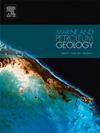Fault interactions and role of preexisting structures on the geometry of conjugate transfer zones: Structural insights from Cairo-Suez District, Egypt
IF 3.7
2区 地球科学
Q1 GEOSCIENCES, MULTIDISCIPLINARY
引用次数: 0
Abstract
The Cairo-Suez District (CSD), located in the northwestern sector of the Gulf of Suez rift, is characterized by significant structural complexity, including an intricate network of extensional faults and transfer zones. This study focuses on the Gebel El-Himeira and northern Gebel Ataqa areas, situated at the eastern part of the CSD. This research aims to clarify the internal architecture of these areas through detailed geological field mapping, structural data collection, and satellite imagery analysis. The primary objectives are to establish the geometry of the transfer zones, decipher their deformation history, and understand the influence of their evolution on syn-tectonic sedimentation. The structural analysis of the mapped areas reveals that the Gebel El-Himeira and northern Gebel Ataqa regions represent two prominent conjugate divergent transfer zones which formed between adjacent bounding faults that dip away from each other. The results indicate that the development of both transfer zones began during the Late Eocene and led to dissimilar geometries. This difference in geometry is attributed to the role of reactivated preexisting faults. The growth and propagation of these transfer zones exert significant control on syn-sedimentation processes. These findings provide valuable analogues for subsurface mapping and enhance the understanding of structural controls on hydrocarbon accumulation and migration pathways in similar rift-related basins.
求助全文
约1分钟内获得全文
求助全文
来源期刊

Marine and Petroleum Geology
地学-地球科学综合
CiteScore
8.80
自引率
14.30%
发文量
475
审稿时长
63 days
期刊介绍:
Marine and Petroleum Geology is the pre-eminent international forum for the exchange of multidisciplinary concepts, interpretations and techniques for all concerned with marine and petroleum geology in industry, government and academia. Rapid bimonthly publication allows early communications of papers or short communications to the geoscience community.
Marine and Petroleum Geology is essential reading for geologists, geophysicists and explorationists in industry, government and academia working in the following areas: marine geology; basin analysis and evaluation; organic geochemistry; reserve/resource estimation; seismic stratigraphy; thermal models of basic evolution; sedimentary geology; continental margins; geophysical interpretation; structural geology/tectonics; formation evaluation techniques; well logging.
 求助内容:
求助内容: 应助结果提醒方式:
应助结果提醒方式:


